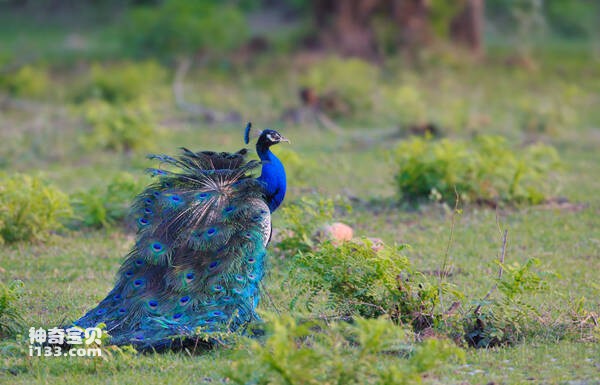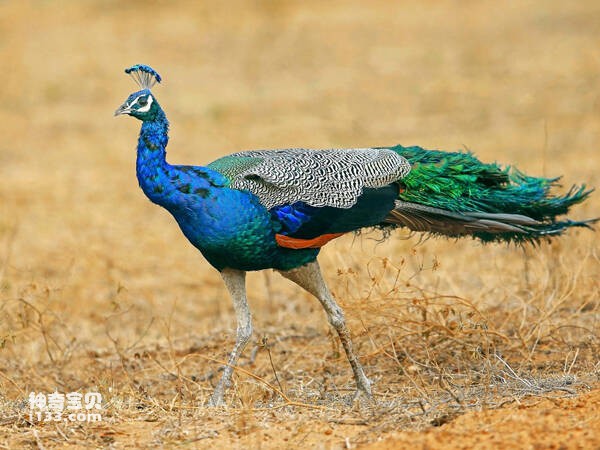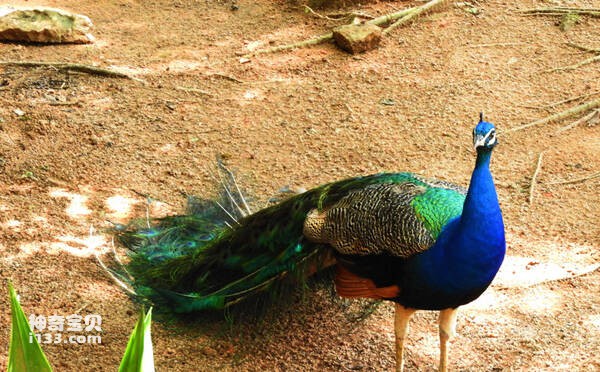Pavo cristatus
IUCN
LCBasic Information
Scientific classification
- name:Pavo cristatus
- Scientific Name:Pavo cristatus,Common Peafowl,Indian Peafowl,Peafowl
- Outline:Landfowl
- Family:Chickeniformes P.family P.Genus
Vital signs
- length:90-230cm
- Weight:4-6kg
- lifetime:20-25years
Feature
The male has an erect occipital crown, ornate plumage, and a particularly extended tail covering
Distribution and Habitat
Origin: Bangladesh, Bhutan, India, Nepal, Pakistan and Sri Lanka.
Introduced to: Australia, Bahamas, New Zealand, USA (Hawaii Island).
It inhabits open and sparse grasslands or open areas with shrubs and bamboo thickets below 2000 m, from plains to high mountains in forests and shrubland. Prefers to live near streams. One male and multiple female group activity. At night they roost in the high branches.
Appearance
The blue peacock is 90-230 cm long, with a wingspan of 130-160 cm and a weight of 4-6 kg. The male has a crest on his head and a white stripe above and below his eye. The top, neck and chest are blue. The cover of the wings is dark brown, and the flight feathers are yellowish brown. Abdomen dark green or black. The cover on the tail forms the tail shield. The female bird has a crest on its head. The upper part of the head and neck is chestnut brown, with green feathers. The eyebrows, face and throat are white. The lower neck, upper back and upper chest are green. The rest of the upper body is drab brown. Wings with white margins. The lower chest is dark brown. The abdomen is dark yellow. The iris is brown. The legs and feet are brown.
There are some differences between blue and green peacocks. Adult wild green peacocks are large in size, but timid and alert in nature. Green peacocks step on larger and longer footprints, and green peacocks have long feet respectively, just like two s
Details
Blue peacock (Pavo cristatus) Common Peafowl, Indian Peafowl, Peafowl, no subspecies.

In the wild or domestic, blue peacocks naturally select mates, that is, one male and multiple females (1:3-5), family-style activities, within a certain range of activities, collective feeding and roost, very few individual activists, once lost one will be noisy, and the other group of individuals will not be adopted.
Blue peacocks feed mainly on plants, but also eat locusts, crickets, moths, termites, frogs, lizards and other animals. In the case of captive breeding, corn, wheat, bran, sorghum, soybean and soybean cake and grass mainly, plus fish meal, bone meal, salt, gravel, multi-vitamins, trace elements, amino acids, additives, etc., can be based on feeding conditions. Like to eat pears, yellow bubbles and other fruits, but also eat rice, seedlings, grass seeds and other food, in addition to eat some insects such as crickets, locusts, and some small reptiles. The animal food of peacock is mainly termites.
The blue peacock's wings are not developed, not good at flying, and the feet are strong and strong, good at walking and running, and most of them run with great stride when fleeing, hunting for food in the early morning and evening, coming to the stream to drink water and wash their feathers in the morning, and then going to the woods to forage together, resting in the shady woods in the hot noon, and eating again at dusk. At night they fly to the branches to rest. Quick action, strong feet, good running, have a certain ability to fly high, male peacocks have courtship behavior and "open the screen" during breeding, and female peacocks can also kiss the head and face of male peacocks with their beak.

Blue peacock male peacock "wow - wow" sound long, cry like crow, very unpleasant. During the breeding period, male peacocks often have violent fights due to contention, and often injure female peacocks.
Blue peacocks breed from June to December. Nest in a hole in the ground in a thicket. The plumage of the male bird is particularly beautiful. Common several male birds follow the female bird around, and the gorgeous tail cover feathers (that is, the tail screen) unfold like a fan, constantly shaking, and friction with each other to produce a "sand-sand" sound. The males also fight over the females. The nest is built among tall grass, such as dense bushes and bamboo beds. The nest is very simple, slightly dug into the ground into a hollow, and lined with weeds, dead branches, fallen leaves, residual feathers, etc. The female lays an egg every other day, mostly at dawn. Four to eight eggs are laid, usually five to six. The egg is obtuse oval, the shell is thick and firm, and slightly shiny; Milky white, brown or milky yellow, not spotted. The eggs are incubated by the female, and it takes 28-30 days for the chicks to hatch, and the chicks have a habit of hiding under the female's tail. Growth is slow, with first-year juveniles slightly similar to females, while male juveniles have more colorful necks. Young birds of the second year are similar to adult birds of the same sex, but the males do not have a tail screen, and the exposed parts of the face are blue and yellow, and the adult feathers are not covered until the third year, when the male chicks have a fully grown tail screen. Sexual maturity is delayed, starting at 22 weeks. Long life, blue peacocks live about 20-25 years longer.

Blue peacock still lacks breed standard and production index, but can be selected according to appearance, weight, growth and development, egg production, hatching rate and other traits. In production practice, individuals with healthy, bright feathers, strong feet and uncurved toes are generally selected. It should be numbered to prevent inbreeding. To this end, we should introduce blue peacocks with different lineages to different units and obtain genealogical data. Blue peacocks and green peacocks can cross, and their hybrid offspring can be fully bred. Blue peacock has quite strong adaptability and disease resistance, but when the environmental conditions and feeding management are not ideal, it is also prone to white dysentery, avian cholera, coccidiosis, pinworm disease. Some areas have also occurred chicken new city disease, fowlpox, Marek's disease and so on. Due to the lack of strict and standardized immunization procedures, many are applied to chicken immunization procedures, so it needs to be further improved. Usually do a good job of cleaning and hygiene regularly, feed deworming drugs, and then carry out immunization work after determining antibodies in the peacock.
In September 2020, the State Forestry and Grassland Administration issued the Notice on Regulating the Scope of Classification Management of Fasting Wild Animals, prohibiting breeding activities for food purposes, and allowing breeding for non-food purposes such as medicine, display, and scientific research.
Listed on the International Union for Conservation of Nature (IUCN) 2016 Red List of Threatened Species ver 3.1 - Not Threatened (LC).
Protect wild animals and eliminate wild meat.
Maintaining ecological balance is everyone's responsibility!








